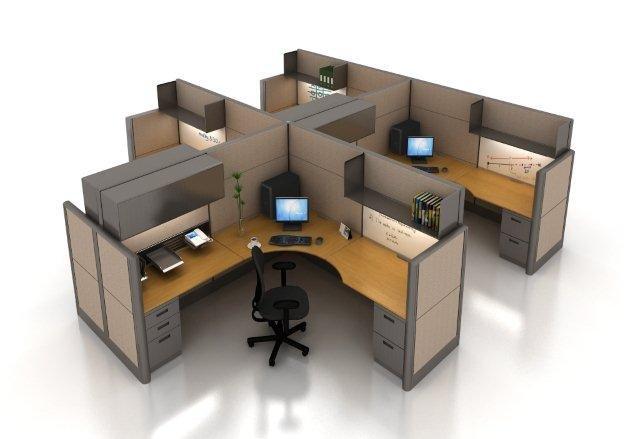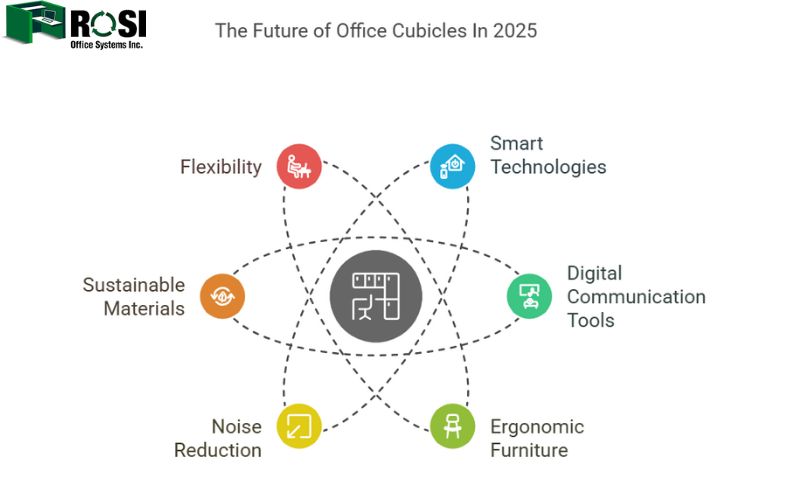
The Evolution of the Office Cubicle In 2025
The common office cubicle has had a big impact on society; from influencing some of the great architects of the modern age, plus sparking debate and studies into the capacity that the average worker’s office environment actually plays. Its evolution has progressed over the years from old-school boring cubicles into innovative productivity-enhancing modern office workspaces.
In 2025, workspace design will be very innovative and exciting. One of the biggest developments in the workplace is the cubicle, whose main purpose was to create an efficient and private workspace.
Today, these private office cubicles are not just a place to sit and work, but also enhance interaction and productivity, and represent creativity and flexibility in the workplace. But how will the evolution of office cubicles be in 2025?
The evolution of office cubicles in 2025 will emphasize flexibility, collaboration, and employee well-being. Modern cubicles will feature modular designs that allow easy reconfiguration to adapt to different work styles, fostering a balance between privacy and teamwork.
Integrated smart technology, such as adjustable lighting, temperature controls, and noise-canceling features, will create a personalized and productive workspace. Sustainability will also play a significant role, with eco-friendly materials and energy-efficient designs becoming standard. These advancements aim to meet the demands of hybrid work models and create office environments that are both functional and inspiring.
First, let’s take a look at the history of office cubicles!

A brief history of the common office cubicle
In the early 1960s, Herman Miller, the founding father of the modern office furniture industry, started the Herman Miller Research Corporation.
The company’s originative mission statement, considering the times, was “not to address any problems with the aesthetics of the furniture itself, but to solve problems relating to the everyday use of the furniture.” Meaning functionality, efficiency, and productivity were the number one product design priorities for the groundbreaking company.
Miller’s associate, Robert Propst, a notable inventor/designer in his own right, strove to delve deep into the normally unanswered, complicated questions about something as seemingly simple as office furniture in Houston. Propst’s in-depth studies included learning how people work together in any given office environment, office layouts, performance, and even how information travels in an office setting.
Through these studies and designs by Robert Propst, under the direction of Herman Miller, the modern Action Office I series was born in 1964.
The company’s next Action Office II line introduced a fresh new modern office concept that highlighted a flexible, semi-enclosed portable office workspace for the average worker.
Thus, the modern office cubicle was born. The invention of the Action Office II cubicle was considered to be one of Herman Miller’s greatest business achievements and one of its company’s biggest all-time sellers.
Even in its infancy, the office cubicle had some well-known critics, namely, the man who was taken off of the company’s cubicle project while it was in development, George Nelson.
Nelson, like most modern-day critics of the office cubicle, felt that the cubicle workspaces that the company was manufacturing were actually dehumanizing. This is what he had to say in 1970 about the product he partially helped to invent:
“One does not have to be an especially perceptive critic to realize that AO-II is definitely not a system that produces an environment gratifying for people in general.
But it is admirable for planners looking for ways of cramming in a maximum number of bodies, for “employees,” for “personnel,” corporate zombies, the walking dead, the silent majority – A large market.” Although George Nelson was a staunch conscientious objector of the modern office cubicle who adamantly did not approve of them, Nelson also realized the dreaded cubicles had great potential for massive office furniture sales worldwide.
According to a Herman Miller company news release, the corporation’s rise to fame was a swift and profitable one with sales totaling $262,000 in 1923 and growing to $25 million by 1970, when it officially started trading its Company Stock publicly.
By the year 2012, its revenue totaled more than $1.7 billion, proving to even its deepest cynics the valuable merits of its original company mission statement, and the ingenious modernistic concept of its 20th-century founders.
In the past decades since the 60s and 70s, the company professes to have associated with some of the best-known modern-day designers in the world, including Alexander Girard, Isamu Noguchi, Bill Stumpf, Don Chadwick, Ayse Birsel, Studio 7.5, Yves Béhar, Doug Ball, and many other talented and well-known collaborators.
Today, the company still provides the classic pieces that they were known for originally, and also offers multiple new designs for the contemporary, up-to-date office as well.
Herman Miller is still widely recognized as a major leader in state-of-the-art interior office furnishings, and for its innovative solutions for leading healthcare environments.
Herman Miller, Inc. is headquartered in Zeeland, Michigan, and has manufacturing facilities in the United States, China, Italy, and the United Kingdom, with sales offices, dealers, licensees, and customers in over 100 countries.
They also operate under the corporate names of Herman Miller Healthcare, Nemschoff, and Geiger International.
In 2015 the cubicle industry is still going strong with plenty of healthy competitors vying for the Herman Miller Corporation’s potential customers.
There are as many cubicle providers now as there were steel desk and hardwood chair manufacturers in the office furniture industry in the socially turbulent 1960s.
Today the industry has also gone “Green”.
Although buying used office cubicles at a discount is nothing new, the industry has opened up to a successful recycling mentality that refurbishes, customizes, and remanufactures ecologically friendly units catering to any style, office décor, or professional workspace design.
The refurbished office cubicle business is also expected to continue to rise in popularity.
Because it also has a rational and innovative mission statement for the modern times – claiming to reduce the office world’s adverse carbon imprint on the planet – remanufactured cubicles are open to an ever-growing green-friendly consumer market.
All in all, the story of the office cubicles’ evolution is not such a boring subject as one may think at first thought or glance.
It is a story that found its roots in history over half a century ago, ripe with innovation, business pitfalls, and successes, intense struggles of different public conceptualizations fighting against the old-school office norm, and common naysayers that were emphatically proven wrong in the end.
What is the Evolution of the Office Cubicle in 2025?

Office cubicles have undergone significant design changes in 2025. The goal of this evolution is to meet the different needs of work in modern workspaces. A comfortable, flexible, and smart office cubicle that allows for the creation of personal and collaborative spaces.
- Office cubicles in 2025 will be equipped with smart technologies that automatically adjust factors such as temperature, lighting, and air quality to provide a pleasant and comfortable environment for employees.
- Modern cubicles in 2025 will also feature advanced digital communication tools such as high-quality sound systems, wireless charging stations, and integrated screens for meetings and video calls.
- As you know, prolonged sitting causes a lot of physical damage to employees. For this reason, ergonomic furniture is designed to ensure the health and comfort of employees during long hours of sitting. Adjustable chairs and desks whose height is adjusted according to the user’s needs are other developments in office cubicles in 2025.
- Other equipment that has been added to cubicles are acoustic panels and noise reduction technologies that provide a quiet space for employees. So they can stay focused on their work without distractions.
- Another evolution of office cubicles in 2025 is the use of sustainable and environmentally friendly materials in their construction. This means that in 2025, more attention will be paid to preserving the environment and reducing office waste.
- The flexibility of cubicles makes them easy to modify to accommodate hybrid or remote work models. They are not fixed, confined spaces like in the past, and employees can change them according to their needs, such as making them a more open space for group meetings and teamwork.
The goal of cubicle changes and evolution is to create a comfortable, efficient, and innovative space that both meets the needs of employees and increases their productivity. In fact, the evolution of cubicles reflects the balance between personal tasks, collaboration, and environmental awareness.

John Ofield is a recognized expert in the office furniture and office cubicle industry in Houston, TX, with over 40 years of experience. As the founder of ROSI Office Systems, he specializes in furniture space planning, custom cubicle designs, modern office chairs and tables, and high-quality commercial furniture. John’s expertise helps businesses enhance productivity and collaboration. He is also dedicated to mentoring entrepreneurs and redefining workspaces to inspire success.